 W
WThis is a list of stationery topics. Stationery has historically pertained to a wide gamut of materials: paper and office supplies, writing implements, greeting cards, glue, pencil cases and other similar items.
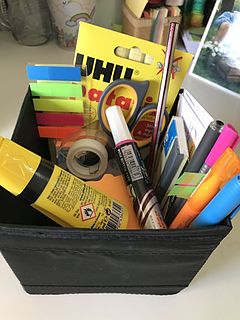 W
WStationery is a mass noun referring to commercially manufactured writing materials, including cut paper, envelopes, writing implements, continuous form paper, and other office supplies. Stationery includes materials to be written on by hand or by equipment such as computer printers.
 W
WAn adhesive label or sticky label is a small piece of paper designed to be affixed to any surface such as paper, plastic, wood, glass, or metal, typically by the action of a layer of adhesive on the front or back of the label. The term adhesive refers to a sticky substance, while something that is self-adhesive implies that it will stick without wetting or the application of glue to the product.
 W
WAdventures in Stationery: A Journey Through Your Pencil Case is a non-fiction book by James Ward about stationery. It was published by British publisher Profile Books in 2014.
 W
WA binder clip, less commonly known as a paper clamp or foldover clip or bobby clip or clasp, is a simple device for binding sheets of paper together. It leaves the paper intact and can be removed quickly and easily, unlike the staple. The term foldback clip is used in the United Kingdom to describe this invention. It is also sometimes referred to as a "handbag clip" because, when not in use, its clip can be folded up to look like a handbag. This feature is used to hold the papers in place even better.
 W
WA brass fastener, brad, paper fastener or split pin is a stationery item used for securing multiple sheets of paper together. A patent of the fastener was issued in 1866 to George W McGill. The fastener is inserted into punched holes in the stack of paper, and the leaves, or tines, of the legs are separated and bent over to secure the paper. This holds the pin in place and the sheets of paper together. For few sheets of paper, holes can be made using the sharp end of the fastener.
 W
WA brush pot is a container for holding the brushes used by scribes for Chinese calligraphy. These are typically carved from bamboo or jade with ornate motifs symbolising concepts such as longevity. Antique examples are now valued highly.
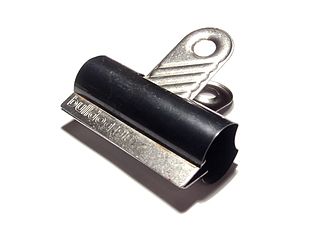 W
WA bulldog clip is a device for temporarily but firmly binding sheets of paper together. It consists of a rectangular sheet of springy steel curved into a cylinder, with two flat steel strips inserted to form combined handles and jaws. The user presses the two handles together, causing the jaws to open against the force of the spring, then inserts a stack of papers and releases the handles. The spring forces the jaws together, gripping the papers firmly.
 W
WBusiness cards are cards bearing business information about a company or individual. They are shared during formal introductions as a convenience and a memory aid. A business card typically includes the giver's name, company or business affiliation and contact information such as street addresses, telephone number(s), fax number, e-mail addresses and website. Before the advent of electronic communication business cards might also include telex details. Now they may include social media addresses such as Facebook, LinkedIn and Twitter. Traditionally, many cards were simple black text on white stock, and the distinctive look and feel of cards printed from an engraved plate was a desirable sign of professionalism. In the late 20th century, technological advances drove changes in style, and today a professional business card will often include one or more aspects of striking visual design.
 W
WA calendar is used to display dates and related information, usually in a table format. Calendars are used to plan future events and keep track of appointments, and so a typical calendar will include days of the week, week numbering, months, public holidays and clock changes. Printed calendars also often contain additional information relevant for specific groups – for instance, a Christian liturgical calendar will show holy days and liturgical colours, while a calendar for amateur astronomers will highlight phases of the moon, conjunctions and eclipses. Alongside their practical uses, calendars have taken on a decorative purpose, offering an easy way to introduce regularly changing artwork to a space, and have even influenced art and sexuality by popularizing the pin-up style.
 W
WA clipboard is a thin, rigid board with a clip at the top for holding paper in place. A clipboard is typically used to support paper with one hand while writing on it with the other, especially when other writing surfaces are not available. The earliest forms were patented in 1870-71 and referred to as board clips. Related to the clipboard is the Shannon Arch File, which was developed around 1877.
 W
WContinuous stationery (UK) or continuous form paper (US) is paper which is designed for use with dot-matrix and line printers with appropriate paper-feed mechanisms. Other names include fan-fold paper, sprocket-feed paper, burst paper, lineflow, tractor-feed paper, and pin-feed paper. It can be single-ply or multi-ply, often described as multipart stationery or forms. Continuous stationery is often used when the final print medium is less critical in terms of the appearance at the edges, and when continuously connected individual sheets are not inconvenient for the application. Individual sheets can be separated at the perforation, and sheets also have edges with punched holes, which also can be removed at the perforation.
 W
WA crayon is a stick of pigmented wax used for writing or drawing. Wax crayons differ from pastels, in which the pigment is mixed with a dry binder such as gum arabic, and from oil pastels, where the binder is a mixture of wax and oil.
 W
WDeli Company is a Chinese stationery manufacturing company based in Ningbo, Zhejiang. Deli is a well-known brand in China, thanks to its national advertisement campaign that is broadcast on CCTV, inviting Yang Lan to participate as the brand ambassador. The company to be the leader in China's stationery market, selling its products to more than 45,000 stores nationwide. Deli also leads the industry's e-commerce business through a strong presence on Tmall and JD.com.
 W
WIn stationery, a Diary, Datebook, Appointment Book, Planner or Agenda is a small book containing a main diary section with a space for each day of the year with room for notes, a calendar, and usually various pages at the beginning and end containing various pieces of reference information, which may include maps and telephone codes, and pages for a short address book at the end. Most diaries are pre-printed for a specific year, which is printed on the cover, with each day's space therefore able to be printed with the day of the week. However diaries that can be used for any year are also produced. Page-marker ribbons are commonly included. The US Customs official definition of a diary is: "A book prepared for keeping a daily record, or having spaces with printed dates for daily memoranda and jottings; also applied to calendars containing daily memoranda on matters of importance to people generally, or to members of a particular profession, occupation, or pursuit".
 W
WA drawing pin or thumb tack is a short nail or pin used to fasten items to a wall or board for display and intended to be inserted by hand, usually using the thumb. A variety of names are used to refer to different designs intended for various purposes.
 W
WEmbossing tape is a labelling medium usually of hard plastic. Embossing tape is used with embossing machines, often handheld. The company name and trademark "Dymo" is often associated with this sort of label as their CEO Rudolph Hurwich first introduced it as a consumer product in 1958. Embossing tape have largely been replaced with thermal transfer printing tape used by label printers, but is returning in popularity as 'vintage' looks become increasingly popular.
 W
WAn envelope is a common packaging item, usually made of thin, flat material. It is designed to contain a flat object, such as a letter or card.
 W
WA file folder is a kind of folder that holds papers and money together for organization and protection. File folders usually consist of a sheet of heavy paper stock or other thin, but stiff, material which is folded in half, and are used to keep paper documents. Files may also contain other things like magazines, cased in music CDs, etc. sometimes mostly not used for any official use, rather used as normal storage in a home. They are often used in conjunction with a filing cabinet for storage. File folders can easily be purchased at office supply stores.
 W
WFoolscap folio is paper cut to the size of 8+1⁄2 × 13+1⁄2 in (216 × 343 mm) for printing or to 8 × 13 in (203 × 330 mm) for "normal" writing paper (foolscap). This was a traditional paper size used in some parts of Europe, and the British Commonwealth, before the adoption of the international standard A4 paper; France for instance traditionally used writing/typing paper known as 21-27 until 1967.
 W
WA highlighter is a type of writing device used to mark attention to sections of text by marking them with a vivid, translucent colour. A typical highlighter is fluorescent yellow, coloured with pyranine. Different compounds, such as rhodamines are used for other colours.
 W
WHindustan Pencils Pvt. Ltd. is an Indian manufacturer of pencils, writing materials and other stationery items, established in 1958 in Bombay. The company makes writing implements under the brands Nataraj and Apsara, and claims to be the largest pencil manufacturer in India. The Nataraj 621 HB wood-cased pencil has a distinctive red-and-black stripe design.
 W
WThe Hipster PDA is a paper-based personal organizer, popularized by Merlin Mann. Originally a tongue-in-cheek reaction to the increasing expense and complexity of personal digital assistants (PDA), the Hipster PDA simply comprises a sheaf of index cards held together with a binder clip. Following widespread coverage in the media and blogs, the hPDA has become a popular personal management tool particularly with followers of David Allen's Getting Things Done methodology.
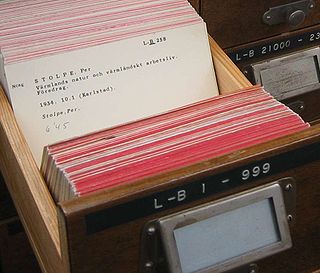 W
WAn index card consists of card stock cut to a standard size, used for recording and storing small amounts of discrete data. A collection of such cards either serves as, or aids the creation of, an index for expedited lookup of information. This system was invented by Carl Linnaeus, around 1760.
 W
WISO 216 is an international standard for paper sizes, used across the world except in North America and parts of Latin America. The standard defines the "A", "B" and "C" series of paper sizes, including A4, the most commonly available paper size worldwide. Two supplementary standards, ISO 217 and ISO 269, define related paper sizes; the ISO 269 "C" series is commonly listed alongside the A and B sizes.
 W
WA label is a piece of paper, plastic film, cloth, metal, or other material affixed to a container or product, on which is written or printed information or symbols about the product or item. Information printed directly on a container or article can also be considered labelling.
 W
WLetter or ANSI Letter is a paper size standard defined by the American National Standards Institute, commonly used as home or office stationery in the United States, Canada, Chile, Colombia, Costa Rica, Mexico, Panama, Guatemala, the Dominican Republic and the Philippines. It measures 8.5 by 11 inches, similar to the A4 paper standard used by most other countries, defined in ISO 216 by the International Organization for Standardization.
 W
WIn philatelic terminology a letter sheet, often written lettersheet, is a sheet of paper that can be folded, usually sealed, and mailed without the use of an envelope, or it can also be a similar item of postal stationery issued by a postal authority. Letter sheets derive from the form in which written correspondence was made up before the mid-19th century — letters were written on one or more sheets of paper that were folded and sealed in such a way that the address could be written on the outside.
 W
WA Manila folder is a file folder designed to contain documents. It is generally formed by folding a large sheet of stiff card in half. Though traditionally buff, sometimes other colors are used to differentiate categories of files.
 W
WA marker pen, fine liner, marking pen, felt-tip pen, flow marker, sign pen, vivid, texta, sketch pen or koki, is a pen which has its own ink source and a tip made of porous, pressed fibers such as felt.
 W
WA notebook is a book or stack of paper pages that are often ruled and used for purposes such as recording notes or memoranda, other writing, drawing or scrapbooking.
 W
WA paper clip (paperclip) is a device used to hold sheets of paper together, usually made of steel wire bent to a looped shape. Most paper clips are variations of the Gem type introduced in the 1890s or earlier, characterized by the almost two full loops made by the wire. Common to paper clips proper is their utilization of torsion and elasticity in the wire, and friction between wire and paper. When a moderate number of sheets are inserted between the two "tongues" of the clip, the tongues will be forced apart and cause torsion in the bend of the wire to grip the sheets together.
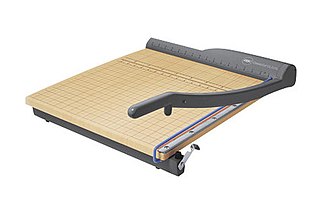 W
WA paper cutter, also known as a paper guillotine or simply guillotine, is a tool often found in offices and classrooms, designed to cut a large amount of paper sheets to be able to issue a document with a straight line in one swift slice.
 W
WPaper size standards govern the size of sheets of paper used as writing paper, stationery, cards, and for some printed documents.
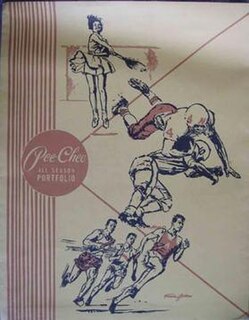 W
WThe yellow Pee-Chee All Season Portfolio was a common American stationery item in the second half of the 20th century, commonly used by students for storing school papers. It was first produced in 1943 by the Western Tablet and Stationery Company of Kalamazoo, Michigan. Pee-Chees were later produced by the Mead Corporation.
 W
WA pen is a common writing instrument that applies ink to a surface, usually paper, for writing or drawing. Early pens such as reed pens, quill pens, dip pens and ruling pens held a small amount of ink on a nib or in a small void or cavity which had to be periodically recharged by dipping the tip of the pen into an inkwell. Today, such pens find only a small number of specialized uses, such as in illustration and calligraphy. Reed pens, quill pens and dip pens, which were used for writing, have been replaced by ballpoint pens, rollerball pens, fountain pens and felt or ceramic tip pens. Ruling pens, which were used for technical drawing and cartography, have been replaced by technical pens such as the Rapidograph. All of these modern pens contain internal ink reservoirs, such that they do not need to be dipped in ink while writing.
 W
WA pencil is a writing or drawing implement with a solid pigment core encased in a sleeve, barrel, or shaft that prevents breaking the core or marking a user's hand.
 W
WA pencil case or pencil box is a container used to store pencils. A pencil case can also contain a variety of other stationery such as sharpeners, pens, glue sticks, erasers, scissors, rulers and calculators.
 W
WA personal organizer, datebook, date log, daybook, day planner, personal analog assistant, personal planner, year planner, or agenda, is a small book or binder that is designed to be portable. It usually contains a diary, calendar, address book, blank paper, and other sections. The organizer is a personal tool and may also include pages with useful information, such as maps and telephone codes. It is related to the separate desktop stationery items that have one or more of the same functions, such as appointment calendars, rolodexes, notebooks, and almanacs.
 W
WA Post-it Note is a small piece of paper with a re-adherable strip of glue on its back, made for temporarily attaching notes to documents and other surfaces. A low-tack pressure-sensitive adhesive allows the notes to be easily attached, removed and even re-posted elsewhere without leaving residue. Originally small yellow squares, Post-it Notes and related products are available in various colors, shapes, sizes and adhesive strengths. As of 2019, there are at least 26 documented colors of Post-it Notes.
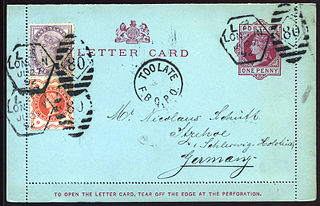 W
WA piece of postal stationery is a stationery item, such as a stamped envelope, letter sheet, postal card, lettercard, aerogram or wrapper, with an imprinted stamp or inscription indicating that a specific rate of postage or related service has been prepaid. It does not, however, include any postcard without a pre-printed stamp.
 W
WPressure-sensitive adhesive is a type of non reactive adhesive which forms a bond when pressure is applied to bond the adhesive with a surface. No solvent, water, or heat is needed to activate the adhesive. It is used in pressure-sensitive tapes, labels, glue dots, note pads, automobile trim, and a wide variety of other products.
 W
WPressure-sensitive tape, known also in various countries as PSA tape, adhesive tape, self-stick tape, sticky tape, Sellotape, or just tape, is an adhesive tape that will stick with application of pressure, without the need for a solvent or heat for activation. It can be used in the home, office, industry, and institutions for a wide variety of purposes.
 W
WRing binders are large folders that contain file folders or hole punched papers. These binders come in various sizes and can accommodate an array of paper sizes. These are held in the binder by circular or D-shaped retainers, onto which the contents are threaded. The rings themselves come in a variety of sizes, including 0.5, 1, 1.5, and 2 inches, though other sizes are also available. The rings are usually spring-loaded, but can also be secured by lever arch mechanisms or other securing systems. The binders themselves are typically made from plastic with metal rings. Early designs were patented during the early 1890s to the early 1900s.
 W
WRose & Frank Co v JR Crompton & Bros Ltd [1924] UKHL 2 is a leading decision on English contract law, regarding the intention to create legal relations in commercial arrangements. In the Court of Appeal, Atkin LJ delivered an important dissenting judgment which was upheld by the House of Lords.
 W
WA Royal Mail rubber band is a small red elastic loop used by the postal delivery service in the United Kingdom. In the course of its work, the Royal Mail consumes nearly one billion rubber bands per year to tie together bundles of letters at sorting offices. In the 2000s, complaints about Royal Mail rubber bands littering the streets of Britain gave rise to ongoing press interest in this minor cultural phenomenon. Royal Mail changed to brown bands some years ago
 W
WA rubber band is a loop of rubber, usually ring or oval shaped, and commonly used to hold multiple objects together. The rubber band was patented in England on March 17, 1845 by Stephen Perry. Most rubber bands are manufactured out of natural rubber or, especially at larger sizes, elastomer, and are sold in a variety of sizes.
 W
WA ruler, sometimes called a rule or line gauge, is a device used in geometry and technical drawing, as well as the engineering and construction industries, to measure distances or draw straight lines.
 W
WA spindle is an upright spike used to temporarily hold papers. "Spindling" or "spiking" is the act of spearing an item onto the spike. A spindle was often used in restaurants to hold orders from the waitstaff to the kitchen.
 W
WA springback binder is a device for rapid and repeated binding of loose-leaf collections into books.
 W
WA staple is a type of two-pronged fastener, usually metal, used for joining or binding materials together. Large staples might be used with a hammer or staple gun for masonry, roofing, corrugated boxes and other heavy-duty uses. Smaller staples are used with a stapler to attach pieces of paper together; such staples are a more permanent and durable fastener for paper documents than the paper clip.
 W
WA stapler is a mechanical device that joins pages of paper or similar material by driving a thin metal staple through the sheets and folding the ends. Staplers are widely used in government, business, offices, work places, homes and schools.
 W
WA sticker is a type of label: a piece of printed paper, plastic, vinyl, or other material with pressure sensitive adhesive on one side. They can be used for decoration or for functional purposes, depending on the situation.
 W
WA tickler file or 43 Folders System is a collection of date-labeled file folders organized in a way that allows time-sensitive documents to be filed according to the future date on which each document needs action. Documents within the folders of a tickler file can be to-do lists, pending bills, unpaid invoices, travel tickets, hotel reservations, meeting information, birthday reminders, coupons, claim tickets, call-back notes, follow-up reminders, maintenance reminders, or any other papers that require future action. Each day, the folder having the current date is retrieved from the tickler file so that any documents within it may be acted on. Essentially, a tickler file provides a way to send a reminder to oneself in the future—"tickling" one's memory.
 W
WA trade card is a square or rectangular card that is small, but bigger than the modern visiting card, and is exchanged in social circles, that a business distributes to clients and potential customers, as a kind of business card. Trade cards first became popular at the end of the 17th century in Paris, Lyon and London. They functioned as advertising and also as maps, directing the public to the merchants' stores.
 W
WTrapper Keeper is a brand of loose-leaf binder created by Mead. Popular with students in the United States and parts of Latin America from the 1970s to the 1990s, it featured sliding plastic rings, folders, and pockets to keep schoolwork and papers, and a wrap around flap with a Velcro closure.
 W
WA treasury tag or India tag is an item of stationery used to fasten sheets of paper together or to a folder. It consists of a short length of string, with metal or plastic cross-pieces at each end that are orthogonal to the string. They are threaded through holes in paper or card made with a hole punch or lawyers bodkin or electric drill, and the cross-pieces are sufficiently wide as to not slip back through the holes.
 W
WA visiting card, also known as a calling card, is a small card used for social purposes. Before the 18th century, visitors making social calls left handwritten notes at the home of friends who were not at home. By the 1760s, the upper classes in France and Italy were leaving printed visiting cards decorated with images on one side and a blank space for hand-writing a note on the other. The style quickly spread across Europe and to the United States. As printing technology improved, elaborate color designs became increasingly popular. However, by the late 1800s, simpler styles became more common.
 W
WA watermark is an identifying image or pattern in paper that appears as various shades of lightness/darkness when viewed by transmitted light, caused by thickness or density variations in the paper. Watermarks have been used on postage stamps, currency, and other government documents to discourage counterfeiting. There are two main ways of producing watermarks in paper; the dandy roll process, and the more complex cylinder mould process.